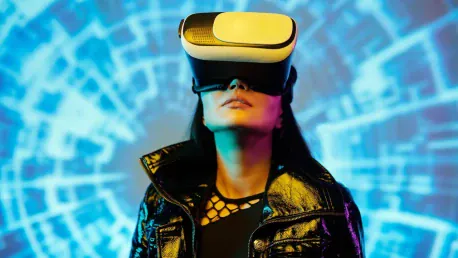Google’s recent unveiling of Android XR, an operating system dedicated to mixed reality (MR) wearables, marks a significant step forward in the tech giant’s efforts to solidify its standing in the augmented reality (AR) and virtual reality (VR) spheres. Generating considerable excitement among enthusiasts and developers, this introduction heralds a future where mixed reality could fundamentally transform daily digital interactions. The announcement positions Google as a potential leader in the AR/VR market, with ambitious plans to integrate the physical and digital worlds in ways we have yet to fully realize.
The Emergence of Android XR
Android XR has been introduced at a time when the AR/VR market is ripe for innovation, particularly following Apple’s Vision Pro headset launch in 2024, which drew significant attention to AR/VR possibilities. Prior to Google’s announcement, there was noticeable stagnation in competitive efforts from Android brands, contributing to an industry craving a unified development platform. Google aims to address this gap comprehensively through Android XR. Positioned as a versatile solution, Android XR distinguishes itself from existing products offered by Meta and Ray-Ban by embracing an open design philosophy and integrating high-profile partners such as Samsung, Qualcomm, and Sony.
Pioneering a unified development platform, Android XR seeks to create a foundation on which developers can create a broad range of apps that work seamlessly across various devices. This approach is accelerated by Google’s strategic collaboration with known industry giants, which not only amplifies the tech’s market reach but also emboldens developer confidence. The introduction of Android XR couldn’t be more timely, providing a fertile ground for a wave of innovative MR applications that resonate well beyond initial enthusiast circles and into mainstream adoption. The excitement surrounding Google’s announcement underscores the industry’s readiness for a catalyst like Android XR to drive the next wave of mixed reality experiences.
Hardware-Agnostic Design
A standout feature of Android XR is its hardware-agnostic design, which breaks away from current solutions often tailored to specific hardware. By envisioning a flexible, unified platform, Android XR aims to be compatible with multiple types of devices, promoting widespread adoption and enabling developers to build applications that can function across various headsets. This adaptability is an attractive proposition for developers, ensuring their works aren’t confined to niche markets or exclusive hardware. Google’s Project Moohan, an initial collaboration with Samsung, embodies this principle by serving as a reference design headset incorporating Android XR, and setting a standard for future AR-enabled devices like smart glasses.
Initial steps involving Project Moohan underscore how Google’s approach can set new precedents in the mixed reality domain. A promising avenue for subsequent devices, such as smart glasses, seems imminent, potentially bringing this technology closer to everyday use scenarios. The shift toward multimodal interaction becomes crucial, emphasizing the need for user experiences that integrate beyond traditional buttons to touch interfaces, eye tracking, and other forms of engagement. This perspective positions Android XR as an essential tool for developers aiming to push the envelope in creating intuitive, human-centered mixed reality applications that adapt to various interaction modes.
Developer-Friendly Environment
A critical element of Android XR’s appeal is its shared codebase with the regular Android OS, making it easier for developers already familiar with Android to transition into MR development. This seamless integration ensures that developers can leverage existing knowledge and tools like Jetpack Compose libraries while taking advantage of new spatial APIs such as OpenXR and WebXR. By streamlining development processes and supporting a vast repository of familiar tools, Google fosters an environment where creating MR applications becomes an extension of existing Android development rather than an entirely new endeavor.
Moreover, Unity developers benefit from ported libraries that become instrumental in AR and VR development, reinforcing Android XR’s developer-friendly narrative. Google’s demo of core Android apps like Maps and Chrome as XR-ready further signifies the potential for a quick ramp-up of functional apps in the XR ecosystem. Compatibility with an established development environment, coupled with the introduction of an Android XR emulator within Android Studio, bolsters the foundation for developers to test and refine their applications effectively. Google’s strategic foresight in this area ensures that the development community remains engaged and productive, accelerating the proliferation of quality mixed reality applications.
Advanced AI Integration
The infusion of advanced AI elements, particularly Google’s Gemini, exemplifies Android XR’s aspiration towards intelligent interaction. Gemini, evolving from Google Assistant, is central to Android XR’s functionality, facilitating tasks like rearranging virtual windows based on eye movement and providing contextual information in real-time. These capabilities demonstrate how AI can enhance mixed reality environments through predominantly audiovisual interactions complemented by gesture and body movement tracking. AI’s role in XR is not merely additive but transformative, weaving intelligent responses and adaptability into the core fabric of user interactions.
Gemini’s integration paves the way for features such as real-time translations, navigation, and interactive elements that respond predictably to user inputs. This level of sophistication indicates a shift towards a more intuitive form of interaction, where technology anticipates and adapts to the user’s needs seamlessly. The real-time capabilities of Gemini, demonstrated through specific XR tasks, highlight the potential for creating dynamic, responsive environments that elevate user engagement. Thus, Android XR not only provides a robust platform but also layers it with intelligent, responsive AI features that redefine the ways users interact with digital content.
Circle to Search (CtS) and Immersive Experiences
A prominent feature highlighted at the developer’s event is Circle to Search (CtS), which was initially introduced during the Samsung Galaxy S24 launch. This feature now extends into mixed reality, enabling users to activate search functionalities through simple pinch gestures, thus bypassing cumbersome actions within a headset. The seamless integration of voice prompts and Gemini-driven search results ensures that users can interact naturally and efficiently within their mixed reality environments. This mirroring of current smartphone experiences within an MR setting significantly enhances usability and user comfort.
Google’s demonstrations also showcased a departure from conventional app usage, spotlighting new immersive experiences within the XR space for apps like Google Photos and Google TV. For instance, Google Photos now supports lifelike reconstructions of images, offering a heightened sense of immersion, while platforms like YouTube and Google TV transition from regular screens into immersive experiences that enrich VR content viewing. This adaptive transition ensures that user familiarity with existing apps is preserved while adding value through an additional dimension in a mixed reality setting. These innovations illustrate how typical applications can evolve, leveraging the capabilities of MR to provide more engaging and intuitive user experiences.
Everyday Applications and Shared Experiences
One of Android XR’s compelling promises lies in its potential functionality for AR glasses, poised to revolutionize everyday tasks. Google demonstrated how XR could transform daily activities, such as by projecting navigation details through Google Maps directly onto XR-enabled smart glasses. This would facilitate unobstructed and intuitive guidance while users are on the move. The vision extends to practical applications like DIY tasks, with AR glasses overlaying instructions within the user’s view for real-time, enhanced guidance. The anticipation surrounding these functionalities signals an exciting roster of applications awaiting development, pushing the boundaries of current technological capabilities and bringing advanced usability into accessible form factors like glasses.
In addition to individual use cases, Android XR also supports shared multiple-user experiences. A significant aspect highlighted in Google’s demo was the ease of passing the headset from one user to another without significant interruptions in functionality. This seamless handoff suggests broader applications such as collaborative environments or shared learning experiences, indicating that Android XR could serve as a bridge for collective MR engagements. The absence of visible reliance on voice matching or gesture recalibration highlights an advanced interoperability within Android XR’s architecture, pointing to an inclusive and dynamic future for mixed reality applications.
Industry Collaborations and Future Prospects
Google’s recent introduction of Android XR, a dedicated operating system for mixed reality (MR) wearables, marks a pivotal moment in the tech giant’s quest to fortify its position in the augmented reality (AR) and virtual reality (VR) markets. This debut has generated significant enthusiasm among tech enthusiasts and developers alike, signaling a future where mixed reality could revolutionize the way we interact with digital content in our daily lives. The development not only underscores Google’s commitment to pushing technological boundaries but also positions it as a potential leader in the competitive AR/VR landscape. With Android XR, Google aims to seamlessly blend the physical and digital worlds, creating immersive experiences that we have only begun to imagine. This move suggests ambitious plans to integrate MR into various aspects of daily human life, fundamentally transforming how we perceive and engage with reality. Joining the ranks of innovative tech companies, Google is setting the stage for a future where the possibilities of AR and VR are boundless.









